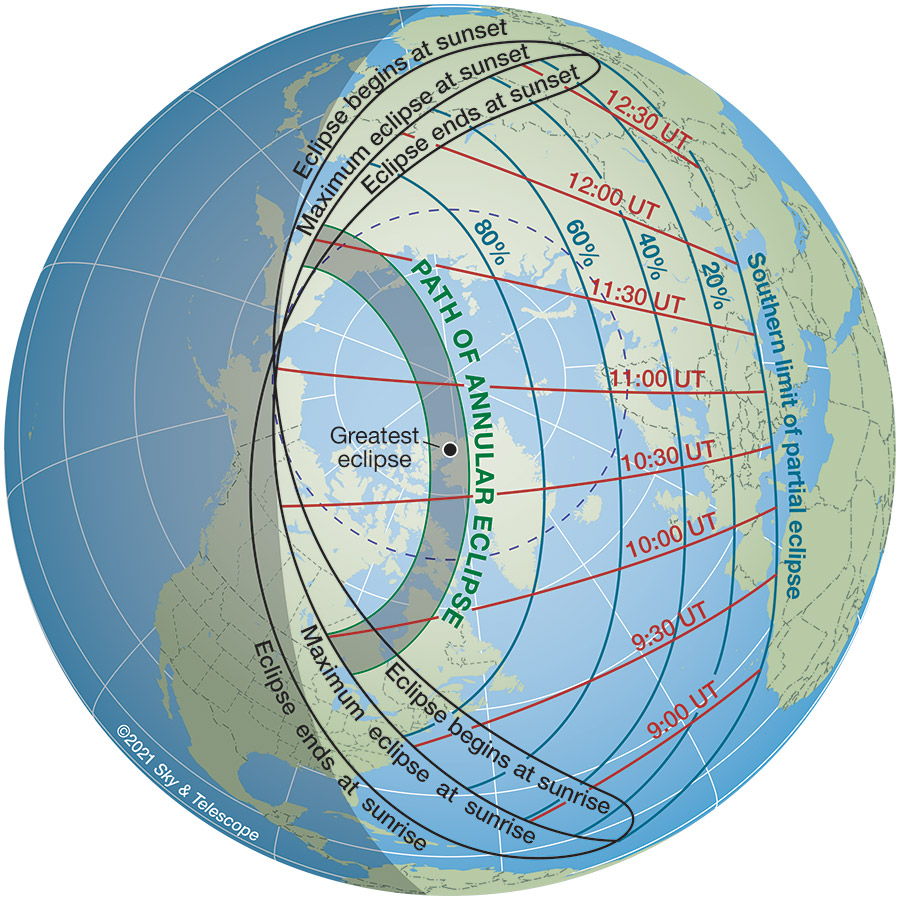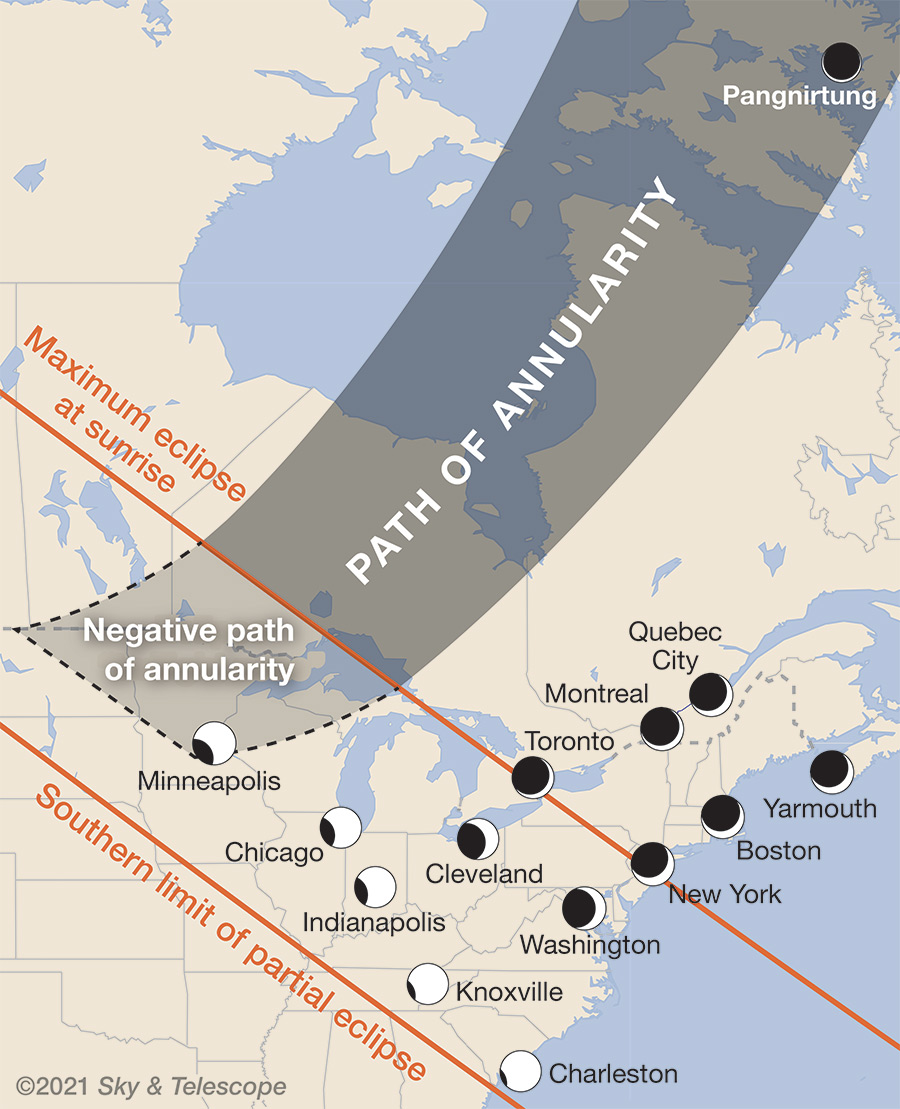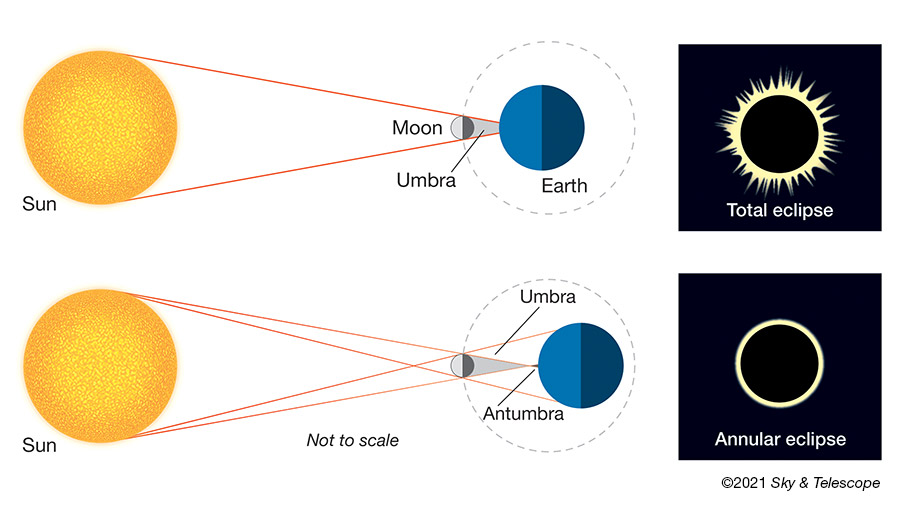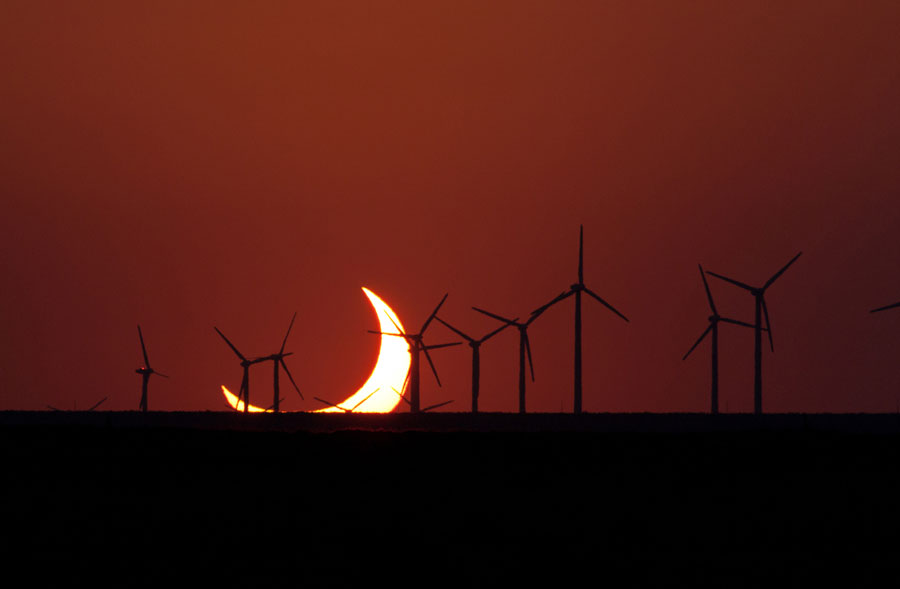Two weeks after a total eclipse of the Moon, skywatchers in some parts of North America will witness an annular or partial eclipse of the Sun.
Contacts:
Diana Hannikainen, Observing Editor, Sky & Telescope
+1 617-500-6793 x22100, [email protected]
Rick Fienberg, Press Officer, American Astronomical Society
+1 202-328-2010 x116, [email protected]
Gary Seronik, Consulting Editor, Sky & Telescope
[email protected]
Note to Editors/Producers: This release is accompanied by high-quality graphics; see the end of this release for the images and links to download.
On Thursday morning, June 10th, viewers across the north and northeastern part of North America can witness — weather permitting — the continent’s first eclipse of the Sun since August 2017.
If you happen to find yourself on a swath of land that runs from southern Ontario and across Hudson Bay in northern Canada, you’ll witness a very special event: an annular eclipse. Unlike a total eclipse, on June 10th the new Moon won’t completely blot out the Sun. The result is a brilliant ring of light that blazes around the black silhouette of the Moon. See below for advice on how to view this safely.
The word “annular” comes from the Latin annulus, which means “ring.” Annular eclipses occur when the Moon is near apogee, the farthest point in its orbit around Earth, and so it appears smaller in the sky than the Sun.
The path of annularity continues from Hudson Bay across Greenland, the Arctic, and into northeastern Russia. Most of Europe, most of Russia, and parts of Asia will be privy to partial phases.
For anyone in a small patch of land comprising northwestern Michigan, much of Minnesota, northeastern North Dakota, southeastern Manitoba, and southwestern Ontario, the Sun will be in annular eclipse before sunrise — this is the negative path of annularity. Pay attention to the quality of the light as morning twilight brightens and then seemingly pauses for a while before resuming to wash away the night.
If you’re outside the path of annularity (but within the area of visibility), you should see partial phases of the eclipse — the Sun will appear to have a bite taken out of it. That bite is the silhouette of the new Moon, and its size will depend on your location. As the Sun climbs higher and the Moon moves along in its orbit, the bite gets smaller and eventually disappears.
In some locations, the partial eclipse is already underway as the Sun rises. “It’ll be worth scouting around ahead of time for an unobstructed view to the northeastern horizon,” says Sky & Telescope’s observing editor Diana Hannikainen. “You should witness a thrilling sight on the morning of June 10th as the horns of the solar crescent float into view above the horizon.” Bring a camera and a safe solar filter that fits over the front of the lens for a chance to take some extraordinary photos. For a how-to, see Sky & Telescope’s article How to Safely Photograph the Sun.
Here’s a selection of timings associated with the eclipse on June 10th:
Local Circumstances of the June 10th Solar Eclipse
| Location | Sunrise | Maximum eclipse | Eclipse ends | ||
| Time | Obscuration | Sun’s Altitude | |||
| New York, NY | 5:24 | 5:32:49 | 72.5% | 0.6° | 6:30:55 |
| Boston, MA | 5:07 | 5:33:20 | 72.9% | 3.3° | 6:32:37 |
| Hartford, CT | 5:15 | 5:33:25 | 73.1% | 2.0° | 6:32:09 |
| Manchester, NH | 5:06 | 5:34:27 | 74.0% | 3.6° | 6:33:53 |
| Portland, ME | 4:59 | 5:34:46 | 74.1% | 4.7° | 6:34:42 |
| Syracuse, NY | 5:25 | 5:37:12 | 77.3% | 1.0° | 6:35:39 |
| Burlington, VT | 5:08 | 5:37:31 | 77.3% | 3.6° | 6:37:04 |
| Montreal, PQ | 5:05 | 5:39:10 | 78.8% | 4.2° | 6:38:58 |
| Quebec City, PQ | 4:51 | 5:39:56 | 78.8% | 6.4° | 6:40:41 |
| Toronto, ON | 5:36 | 5:40:05 | 80.2% | 0.6° | 6:38:02 |
| Yarmouth, NS | 5:42 | 6:33:03 | 71.3% | 7.2° | 7:33:58 |
Obscuration is the fractional area of the Sun's disk covered by the Moon. All times are local and a.m. View an image of the table here.
How to View the Eclipse Safely
During annularity on June 10th, only 89% of the area of the Sun’s disk will be covered by the Moon. This results in less change in the quality of daylight than you might expect. For those outside the path of annularity, the dimming will be even less and may be imperceptible.
You might be tempted to look at the Sun directly. Don’t! The ring of sunlight blazing out from behind the Moon will remain blindingly bright — literally so. If you have your eclipse glasses from the 2017 event, make sure you check them very carefully for tears, scratches, or pinholes. If they’re intact, you’re good to go. Otherwise, purchase another pair. Remember, ordinary sunglasses won’t do the job.
Another neat way to see the eclipse is to create a pinhole projector by poking a small hole in a card, holding it in sunlight with your back to the Sun, and holding a second card about three feet farther away in the first card’s shadow. Or you can project onto the ground directly. Do not look at the Sun through the pinhole! Check out these Sun-viewing methods that Sky & Telescope recommends.
Cartographer Michael Zeiler presents detailed maps and graphical information on his website. In particular, see his diagram of how the rising Sun will appear as seen from many more cities.
If you miss this eclipse or are in an unfavorable location, you have two more chances coming up. October 14, 2023, will see the next annular eclipse, one that will cover a broader path across the U.S. from the West Coast, through the Southwest, and finishing in the Gulf of Mexico. And gear up for April 8, 2024: that date will see the first North American total solar eclipse since 2017. The path of totality crosses Mexico, then stretches northeast from Texas to Maine, and leaves the continent in the Canadian Maritime Provinces. See the American Astronomical Society’s eclipse info page for details.
Read more on this eclipse in the June 2021 issue of Sky & Telescope and on S&T's website: A Sunrise Annular Solar Eclipse.
Sky & Telescope is making the illustrations below available to editors and producers. Permission is granted for nonexclusive use in print and broadcast media, as long as appropriate credits (as noted) are included. Web publication must include a link to skyandtelescope.org.

Across the Top End The path of the annular eclipse of June 10th stretches from southern Ontario, across Hudson Bay, into Greenland, over the Arctic, and finishes in northeastern Russia. Greatest eclipse occurs just off the coast of Greenland, where maximum annularity will last 3 minutes and 51 seconds.
Sky & Telescope

Annularity and Partial Phase Coverage The icons show the depth of the eclipse visible from select cities that will see partial phases of the event. In some locations, the Sun will be eclipsed as it rises, creating the opportunity for some thrilling photos containing foreground scenery. In the negative path of annularity, maximum eclipse occurs before sunrise — if you live in these areas, you might notice unusual twilight effects.
Sky & Telescope

Geometry of an Eclipse When the new Moon is just at the right distance in its orbit to completely blot out the Sun, we witness a total solar eclipse in all its glory (and only then can look directly at the Sun without protection). But when the new Moon is slightly farther from Earth in its orbit, it doesn’t quite cover the full solar disk. In these cases, we can enjoy the sight of a blazing ring of sunlight encircling the silhouette of the Moon — but must take care to observe only through a safe solar filter.
Sky & Telescope

Solar Crescent This photo is from the May 20, 2012, deep partial eclipse as seen from the U.S. Southwest as the Sun was setting. The June 10th event could present a similar sight to some viewers, but with the Sun rising above the northeastern horizon instead.
Evan Zucker
 0
0
Comments
You must be logged in to post a comment.